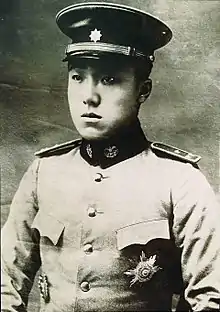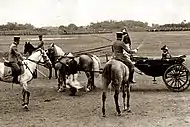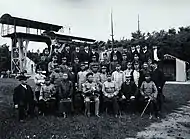Zaitao
Zaitao (23 June 1887 – 2 September 1970), courtesy name Shuyuan, art name Yeyun, was a Manchu prince of the Qing dynasty. He was a half-brother of the Guangxu Emperor and an uncle of Puyi, the last Emperor of China.
| Zaitao | |||||
|---|---|---|---|---|---|
| Beile and acting Junwang | |||||
 Zaitao | |||||
| Beile (of the Prince Zhong peerage) | |||||
| Tenure | 1900–1945 | ||||
| Predecessor | Zaiying | ||||
| Successor | none | ||||
| Born | 23 June 1887 Beijing, | ||||
| Died | 2 September 1970 (aged 83) Beijing, | ||||
| Burial | |||||
| Consorts | Jiang Wanzhen (died 1949)Zhou Mengyun (div. 1949)Jin Xiaolan (died 1967)Wang Naiwen (m. before 1970) | ||||
| Issue | Pujia Pu'an Pushen Puxi Pushi Yunhui | ||||
| |||||
| House | Aisin Gioro | ||||
| Father | Yixuan, Prince Chunxian of the First Rank | ||||
| Mother | Liugiya Cuiyan | ||||
| Military career | |||||
| Allegiance | |||||
| Service/ | |||||
| Awards | Order of the Double Dragon | ||||
| Zaitao | |||||||
|---|---|---|---|---|---|---|---|
| Traditional Chinese | 載濤 | ||||||
| Simplified Chinese | 载涛 | ||||||
| |||||||
| Shuyuan | |||||||
| Chinese | 叔源 | ||||||
| |||||||
| Yeyun art name | |||||||
| Traditional Chinese | 野雲 | ||||||
| Simplified Chinese | 野云 | ||||||
| |||||||
Biography
Zaitao was born in the Manchu Aisin Gioro clan as the seventh son of Yixuan (Prince Chun). His family was under the Plain Red Banner of the Eight Banners. He was adopted by an older male relative, Yimo (奕謨; 1850–1905), who had no son to succeed him.
In 1890, during the reign of the Guangxu Emperor, Zaitao was granted the title of a second class zhenguo jiangjun. He was promoted to a buru bafen fuguo gong in 1894. In 1898, Zaitao was transferred from Yimo's lineage to the lineage of Yihe (奕詥; 1844–1868), Prince Zhong of the Second Rank, as Yihe's adopted son because Yihe had no son to succeed him. He was made an acting beizi in the same year. In 1902, he was promoted to beile.
In December 1908, Zaitao was made an acting junwang (second-rank prince), even though nominally he still remained as a beile. In the same year, he and Tieliang (鐵良) were appointed as zongsi jicha (總司稽察; a type of inspector-official). A year later, during the reign of the Xuantong Emperor, Zaitao was put in charge of the Military Consultancy (軍諮處). In 1910, he visited eight countries – Japan, the United States, Britain, France, Germany, Italy, Austria, and Russia – to observe and learn from their more advanced armed forces. In May 1910, he was sent to Britain as an ambassador to represent the Qing Empire at the funeral of King Edward VII.[1]
In 1911, Zaitao was appointed as the Minister of the Military Consultancy (軍諮大臣) and placed in charge of the Imperial Guard (禁衛軍), as well as being appointed as chief of general staff.[2] He was also designated as the commander of the Mongol Bordered Yellow Banner. In January 1912, after the fall of the Qing Empire, Zaitao, along with Zaixun and others from the imperial clan, founded the Royalist Party (宗社黨) to preserve their ancestral temple. In 1917, when the warlord Zhang Xun briefly restored Puyi to the throne, Zaitao was appointed as the Commanding Officer of the Imperial Guards.
In 1931, Zaitao was recruited by the Nationalist Government of the Republic of China to join the National Crisis Conference (國難會議). After the People's Republic of China was established in 1949, Zaitao served as a member of the National People's Congress and Chinese People's Political Consultative Conference.
Zaitao fancied horses. In his early years, he studied cavalry warfare in the Saumur Cavalry School in France. After 1949, he served as a consultant on horses in the artillery formation of the People's Liberation Army.
Zaitao was also interested in Beijing opera. He was trained in both long and short range types of performing martial arts, and specialised in playing monkey roles in opera. He was tutored by Yang Xiaolou (楊小樓) and Zhang Qilin (張淇林). Opera actor Li Wanchun (李萬春) trained under Zaitao for three years.
Zaitao died in Beijing in 1970 at the age of 83.
Family
Consorts and Issue:
- Wife, of the Jiang clan (姜氏; 1885–1949), personal name Wanzhen (婉貞)
- First daughter (1904)
- First son (1905)
- Second daughter (1906–1969), personal name Yunhui (韞慧)
- Married Darijaya (1906–1968) of the Alxa Borjigit clan in 1925, and had issue (one son, six daughters)
- Pujia (溥佳; 1908–1979), second son
- Pu'an (溥侒; 1911–1944), third son
- Pushen (溥伸; 1915–1928), fourth son
- Wife, of the Zhou clan (周氏; b. 1894), personal name Mengyun (夢雲)
- Puxi (溥僖; 1924–1983), fifth son
- Wife, of the Jin clan (金氏; 1906–1967), personal name Xiaolan (孝蘭)
- Pushi (溥仕; b. 1940), sixth son
- Wife, of the Wang clan (王氏; 1917–2003), personal name Naiwen (乃文)
Ancestry
| Qianlong Emperor (1711–1799) | |||||||||||||||||||
| Jiaqing Emperor (1760–1820) | |||||||||||||||||||
| Empress Xiaoyichun (1727–1775) | |||||||||||||||||||
| Daoguang Emperor (1782–1850) | |||||||||||||||||||
| He'erjing'e | |||||||||||||||||||
| Empress Xiaoshurui (1760–1797) | |||||||||||||||||||
| Lady Wanggiya | |||||||||||||||||||
| Yixuan (1840–1891) | |||||||||||||||||||
| Bailu | |||||||||||||||||||
| Lingshou (1788–1824) | |||||||||||||||||||
| Imperial Noble Consort Zhuangshun (1822–1866) | |||||||||||||||||||
| Lady Weng | |||||||||||||||||||
| Zaitao (1887–1970) | |||||||||||||||||||
| Deqing | |||||||||||||||||||
| Cuiyan (1866–1925) | |||||||||||||||||||
Gallery
 Zaitao in Qing dynasty court robes.
Zaitao in Qing dynasty court robes. Zaitao in the United States
Zaitao in the United States Zaitao in the United States
Zaitao in the United States Zaitao (centre) in Russia in 1910
Zaitao (centre) in Russia in 1910 Zaitao in Peking in 1911
Zaitao in Peking in 1911 Zaitao with Chinese and Japanese delegates in the Qing embassy in Japan
Zaitao with Chinese and Japanese delegates in the Qing embassy in Japan Zaitao with Qing dynasty military leaders in Austria-Hungary in 1910
Zaitao with Qing dynasty military leaders in Austria-Hungary in 1910
See also
Sources
References
- The Times, May 21, 1910
- Esherick (2013), p. 190
Further reading
- Esherick, Joseph W.; Wei, C.X. George (2013). China: How the Empire Fell. New York: Routledge, Taylor & Francis Group. ISBN 978-0-415-83101-7.